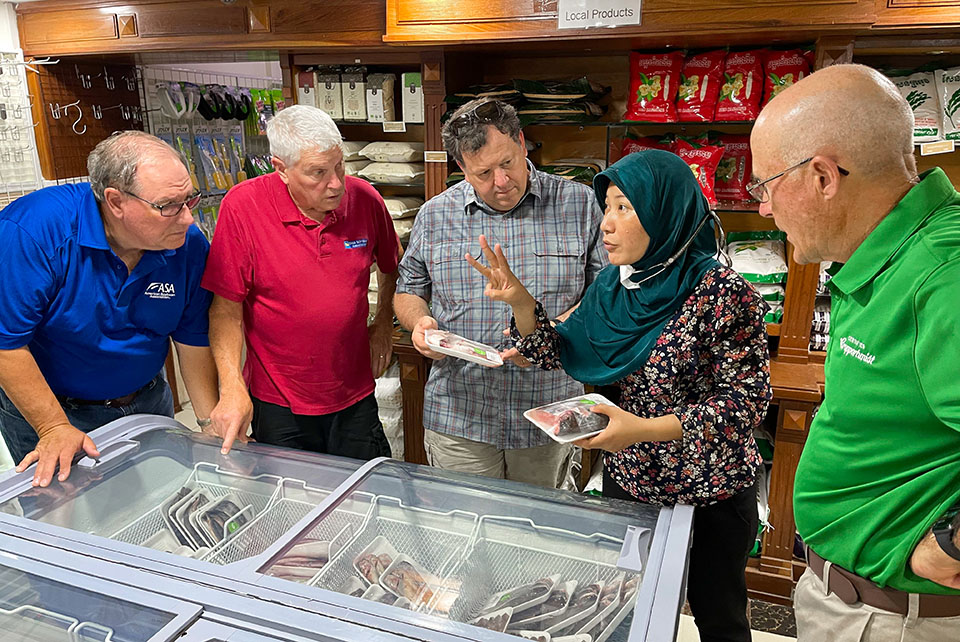
ASA/WISHH trade visit to Cambodia on aquaculture. (Photo courtesy: United Soybean Board)
Soy solutions for every life, every day
November 2, 2023
How do we harness change to feed a growing world? How do we nourish people around the world through innovation, empowerment, mobilization and sustainability?
That was at the heart of the conversation last week during a panel discussion at the World Food Prize Foundation’s Norman E. Borlaug International Dialogue.
During the event, panelists shared perspectives from farming, education, assistance programming and engaging young people to become more involved in agricultural practices and food solutions.
Two areas focused on the power of soybeans and the increased emphasis on aquaculture.
The power of soybeans
Missouri farmer Meagan Kaiser, chair of the United Soybean Board (USB), says American farmers are at the forefront of nutrition, and employ the most sustainable and efficient practices – a commitment U.S. farm families share.
“One of the ways that farmers on the front lines ensure that we have a nutritious crop is by caring for our soils, by taking care of the calcium, magnesium, potassium,” she says. “Those must be in the soil to be in the soybean and it has to be in the soybean to then be in the feed for our animals and their food for our humans, and so it all really does begin on the farm. We also know that our sustainability story doesn't stop at our farm gate; those efficient practices that we utilize on our inputs—with our water , our fuel—all of that ladders up to everybody who chooses U.S. soy.”
Kaiser says partnerships are key in moving products and services around the globe. She pointed to the Soy Excellence Centers (sponsored by the Iowa Soybean Association and other entities) around the world that work together to build opportunities and demand.
One of the ways to build sustainable demand, she says, is to offer technical solutions like In-Pond Raceway Systems (IPRS) for aquaculture and to help farmers globally with the technical expertise to utilize U.S. soybeans.
Kaiser says what she loves about soybeans is the versatility.
Aside from the protein used for food and feed, she pointed out that the oil from soybeans can be used for a myriad of uses – vegetable oil, bio-based products like sustainable aviation fuel and renewable diesel.
“We call it sustainable soy solutions for every life, every day,” she says. “We're talking about not only what's on your plate but the tires that you drive on, the asphalt, your tennis shoes - these are all places where we can help other people in every walk of life live a little bit more sustainably and with a little less carbon footprint.”
Aquaculture
Panelist Dr. David Samveasna of Cambodia says aquaculture is providing an avenue for harnessing change and providing more protein for the world’s diet.
“Aquaculture has been one of the most rapid and technically innovative food sectors globally,” he says, noting that over the past two decades, fish provides 80% of the protein consumption in his country.
Starting on his family’s fish hatchery, Samveasna was the first in Cambodia to introduce IPRS developed by the World Initiative for Soy in Human Health (WISHH).
“We were fortunate to have WISHH introduce us to this climate-smart innovation,” he says.
Samveasna says remarkably the IPRS uses less electricity and creates a high concentration of oxygen levels, allowing the hatchery to raise fish much more quickly than a normal pond.
“This system gives us more productivity, which is another reason that we can tackle all those climate changes (issues) where Cambodia is very vulnerable,” he says.
Samveasna says concepts of the IPRS allows for better safeguarding of the fish compared to a traditional pond, in part, because Cambodia ican see upwards of 70 inches of rain per year.
“People have to protect their fish, so with the fish in the container, we can … use soy-based floating feed more efficiently,” he says.
The IPRS system is also important because Samveasna and others can raise multiple species of the fish, which increases waste, which in turn is used as fertilizer and provides additional income for famers.
“We can show people that this is really a system that can help Cambodian farmers,” he says.
Finding meaning
Kaiser and Samveasna noted that what happens on an American soybean farm directly impacts what happens in Cambodia and around the world.
“Whas was so wonderful is that I got to visit David's family in Cambodia, and it just hit me as we're sitting there that our farm family is connecting with his farm family and many others,” Kaiser says. “We’re in places we’ll never visit, and with people we’ll never meet. How powerful and incredible agriculture is that we get to have that connection.”
Kaiser also recalled an opportunity where a group of Chinese grain buyers visited her farm in Missouri. One of the visitors engaged her then-3-year-old son and they participated in a pedal tractor race.
“I think in that moment it wasn’t about our nations or where we were from, but the fact that we were growing something that was helping someone in their country to eat, to have a better life and to live more sustainably,” she says. “That kind of focus helps us carve through so many issues. So, when we think about all the challenges that we face every day on the farm … if we think about it in a more holistic and altruistic way, we are having an impact on another family - somebody else, some other mother on the other side of the world who gets to tuck her baby into bed with a full belly. That helps us really find meaning in what we do.”
Back